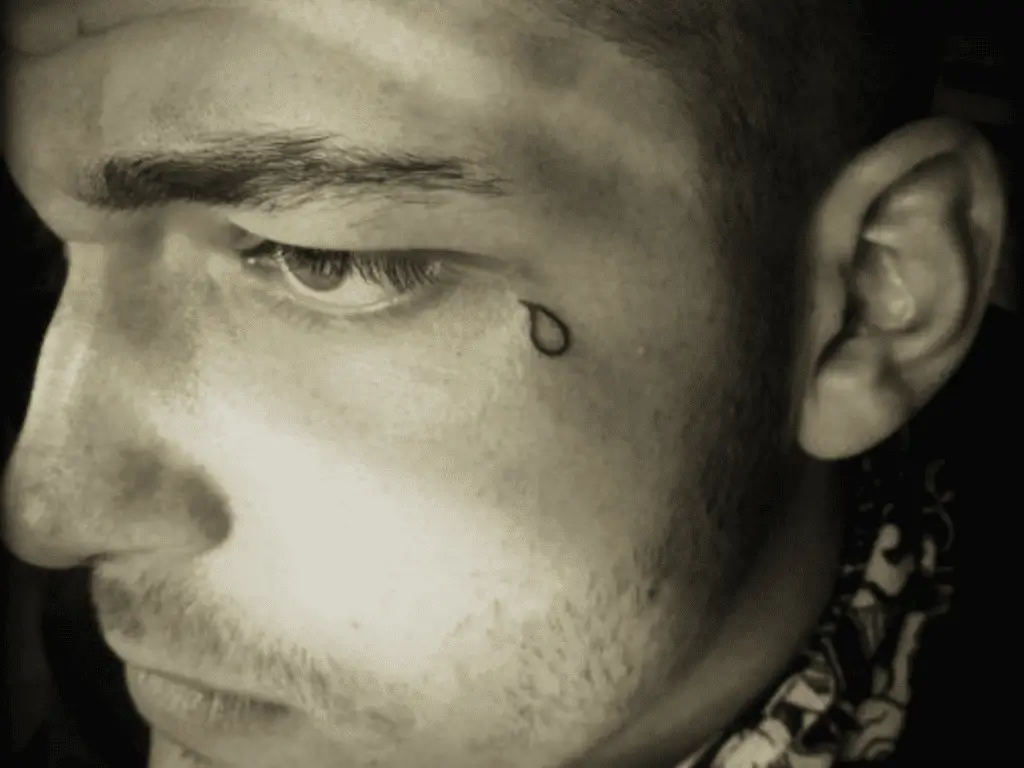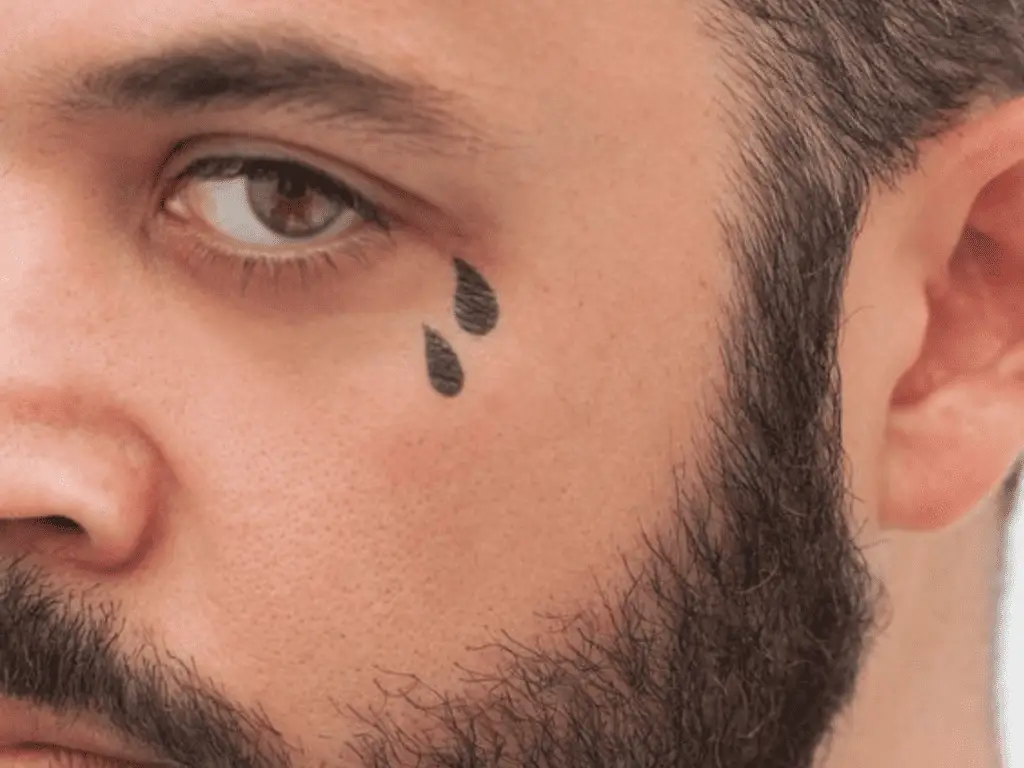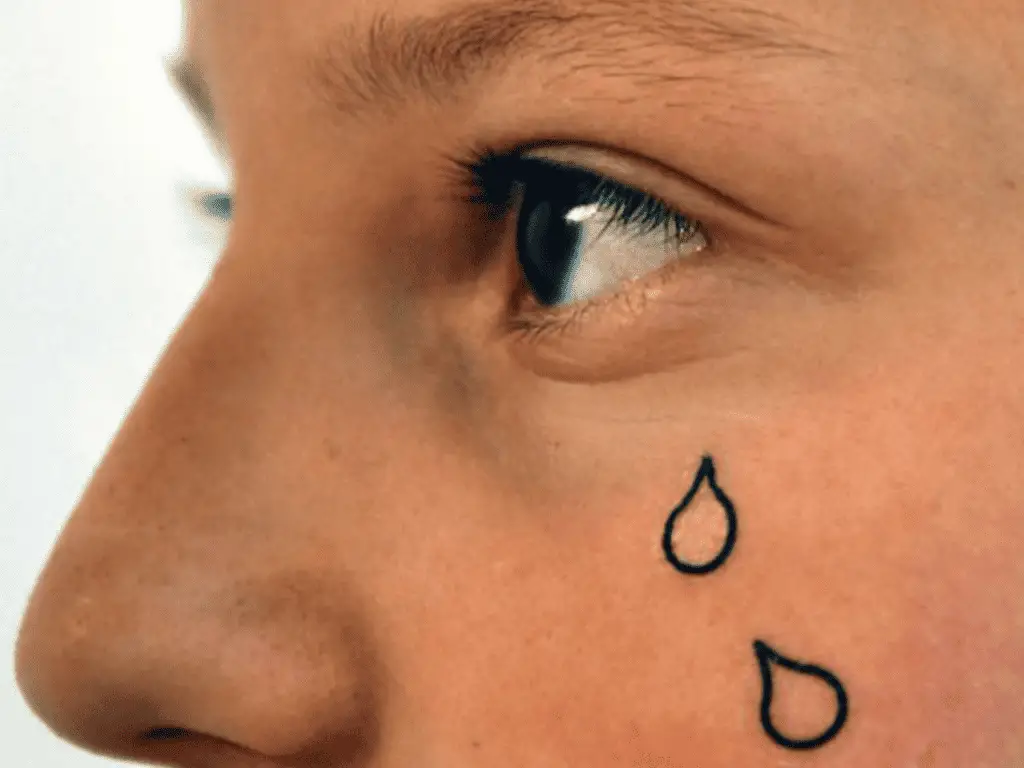The Profound Meanings Behind The Teardrop Tattoo
The teardrop tattoo, a seemingly small and unassuming mark, carries an astonishing weight of meaning, often shrouded in mystery and controversy. Etched typically beneath the eye, this tiny drop of ink has become one of the most recognizable, yet frequently misunderstood, symbols in the world of body art. Far from a simple aesthetic choice, the teardrop tattoo often signifies a deep, personal, and sometimes grim narrative, making it a powerful statement that demands careful consideration and understanding.
For many, the sight of a teardrop tattoo immediately conjures images of criminality, loss, or deep-seated sorrow. Its symbolism is not universal, however, and its interpretation can vary significantly depending on geographic location, subculture, and even the specific details of the tattoo itself—whether it's an outline, filled in, or accompanied by other symbols. This article delves into the complex layers of meaning associated with the teardrop tattoo, exploring its historical roots, its most common interpretations, and the profound implications for those who choose to wear this indelible mark.
Table of Contents
- A Symbol Etched in Controversy: What is the Teardrop Tattoo?
- The Dark Origins: Teardrop Tattoos and Incarceration
- Beyond Bars: Gang Affiliations and Loyalty
- The Silent Grief: Teardrop Tattoos as a Memorial
- The Geographic and Cultural Nuances of the Teardrop Tattoo
- The Perils of the Pigment: Social Stigma and Misconceptions
- Deciding on a Teardrop Tattoo: A Serious Consideration
- The Future of a Controversial Symbol
A Symbol Etched in Controversy: What is the Teardrop Tattoo?
The teardrop tattoo is precisely what its name suggests: a small, drop-shaped tattoo, most commonly placed directly beneath the eye, often at the corner. Its placement is crucial to its impact, as it is one of the most visible and least concealable tattoos. This prominent location ensures that the message it conveys is always on display, making it a bold and often confrontational statement. While its appearance is simple, its connotations are anything but. The teardrop tattoo has become an emblem of complex narratives, ranging from profound sorrow to a dark criminal past, and understanding its various interpretations is key to appreciating its powerful significance.
The Dark Origins: Teardrop Tattoos and Incarceration
The most widely recognized and historically significant meanings of the teardrop tattoo are deeply rooted in prison culture and criminal associations. This connection has largely shaped public perception and continues to be the primary interpretation for many. Within the confines of correctional facilities, where body art often serves as a visual language, the teardrop took on specific, often chilling, significances.
A Mark of Murder or Attempted Murder
Perhaps the most infamous meaning of the teardrop tattoo is its association with murder. In many prison systems, a filled-in teardrop beneath the eye signifies that the wearer has committed a murder. This serves as a permanent badge of a violent act, a grim tally mark for a life taken. It can be a boast, a warning, or a declaration of allegiance to a particular code. The act of receiving such a tattoo within prison walls often solidifies one's status or commitment within a gang or criminal enterprise. An outline of a teardrop, or an unfilled one, can carry a slightly different nuance. It might mean that the wearer has attempted murder, or that they are mourning the death of a close friend or family member who was killed, often with the implication that revenge is sought or has been exacted. This distinction between a filled and an outlined teardrop is critical in deciphering its intended message within these contexts, highlighting the subtle yet profound variations in the teardrop tattoo meaning.
Time Served: A Chronicle of Imprisonment
Another prevalent meaning within the incarcerated population is that the teardrop tattoo represents time spent in prison. Each teardrop, or a single one, could symbolize a significant period of incarceration, or even the loss of freedom itself. In this context, the tattoo becomes a visible record of a person's life behind bars, a testament to their endurance or their past. It can also signify a period of deep suffering or a profound sense of loss for the years stolen by imprisonment. For some, it might be a mark of resilience, a declaration that they survived a harsh environment. The teardrop tattoo, in this interpretation, serves as a permanent reminder of a life lived under lock and key, influencing how the wearer is perceived both inside and outside prison walls.
Beyond Bars: Gang Affiliations and Loyalty
Beyond individual acts or time served, the teardrop tattoo frequently serves as a powerful symbol of gang affiliation and loyalty. In many criminal organizations, especially street gangs, tattoos are a crucial part of identity and hierarchy. The teardrop can signify a member's unwavering commitment to their gang, often earned through violent acts or enduring severe hardship for the group. For example, in some West Coast gangs, a teardrop might indicate that the wearer has killed a rival gang member, thereby solidifying their standing and loyalty. It can also be a sign that a member has lost a close comrade in a gang-related incident, serving as a memorial and a vow of revenge. This specific use of the teardrop tattoo meaning reinforces the wearer's identity within a specific criminal subculture, making them instantly recognizable to allies and rivals alike. It’s a permanent declaration of who they belong to and what they have done for that belonging, a visible testament to their life choices and allegiances.
The Silent Grief: Teardrop Tattoos as a Memorial
While the criminal connotations are the most widely known, it's important to acknowledge that the teardrop tattoo can also carry meanings of profound personal grief and loss, although these interpretations are less common for the prominent under-eye placement and often arise outside of traditional prison contexts. When chosen for these reasons, the tattoo becomes a silent, enduring memorial.
Mourning a Lost Loved One
In some instances, a teardrop tattoo can symbolize the loss of a loved one, particularly if that person died tragically or violently. The tattoo then represents the tears shed for the deceased, a permanent expression of sorrow and remembrance. This meaning is less frequently associated with the under-eye placement, which carries such heavy criminal baggage, but it does exist. When used for grief, the teardrop is a very personal and often deeply emotional symbol. It is a way for the wearer to carry their grief visibly, a constant reminder of someone they have lost. The choice of the teardrop tattoo for mourning can be a very powerful, albeit risky, decision given its other pervasive associations. It is a raw and vulnerable statement of enduring sorrow, a testament to a bond that death could not sever, making the teardrop tattoo meaning incredibly personal for these individuals.
Surviving Trauma or Oppression
More rarely, the teardrop tattoo has been adopted by individuals to signify surviving a traumatic event or overcoming significant oppression. In these cases, the tear represents the pain endured and the resilience shown in the face of adversity. It can be a symbol of having cried countless tears but ultimately emerging stronger. This interpretation seeks to reclaim the symbol from its darker associations, transforming it into a badge of survival rather than criminality. For victims of abuse, human trafficking, or prolonged suffering, a teardrop might represent the tears they were forced to shed and a silent vow that they will never forget what they endured. This particular usage of the teardrop tattoo meaning is an attempt to imbue it with a message of strength and perseverance, shifting its narrative from one of violence to one of survival and hope, though this is a challenging reinterpretation given the prevailing public perception.
The Geographic and Cultural Nuances of the Teardrop Tattoo
The meaning of the teardrop tattoo is not entirely uniform across the globe; its interpretations can vary significantly depending on geographic location and specific cultural contexts. While its association with prison and gang life is most prominent in North America, particularly the United States, other regions may have slightly different, or even entirely unrelated, understandings. For instance, in some European countries, while still rare and often associated with subcultures, the direct link to murder might be less ingrained in public consciousness compared to the US. The evolution of its symbolism is also ongoing. What started as a specific code within incarcerated communities has, over time, permeated popular culture, leading to both widespread recognition and frequent misinterpretations. The internet and media have further complicated its meaning, allowing for both the perpetuation of stereotypes and, occasionally, the emergence of new, personal interpretations that challenge the traditional narrative of the teardrop tattoo.
The Perils of the Pigment: Social Stigma and Misconceptions
One of the most significant aspects of the teardrop tattoo is the immediate and often negative social stigma it carries. Due to its strong association with violence, crime, and incarceration, individuals sporting a teardrop tattoo frequently face judgment, discrimination, and suspicion from the general public, potential employers, and even law enforcement. This stigma can severely impact a person's life, making it difficult to secure employment, housing, or even social acceptance. The visibility of the tattoo means there is no escaping its message, whether or not that message accurately reflects the wearer's personal history or current intentions. Many people who get the tattoo without fully understanding its pervasive criminal connotations later regret it due to the immense social hurdles they encounter. The misconception that every teardrop tattoo signifies murder or a life of crime is deeply ingrained, making it incredibly challenging for individuals who might have acquired it for reasons of grief or personal struggle to convey their true message. This widespread misunderstanding underscores the critical importance of being fully aware of the teardrop tattoo meaning before getting one.
Deciding on a Teardrop Tattoo: A Serious Consideration
Given the profound and often controversial meanings associated with the teardrop tattoo, the decision to get one should never be taken lightly. This is not a tattoo that can be easily concealed or removed without significant effort and expense. Its placement on the face ensures that it will be one of the first things people notice about you, and their immediate assumptions will likely be based on its most notorious interpretations. Therefore, anyone considering a teardrop tattoo must undertake thorough research and deeply reflect on the potential lifelong implications. It is crucial to understand not only the historical and subcultural meanings but also how society at large perceives this particular mark. If the intention is to express grief or personal struggle, it is highly advisable to consider alternative symbols or placements that do not carry such heavy and potentially dangerous connotations. There are countless ways to memorialize a loved one or signify resilience that do not invite the same level of judgment or misinterpretation. The permanence of a tattoo, especially one with such loaded symbolism as the teardrop tattoo, means that careful deliberation is paramount.
The Future of a Controversial Symbol
The teardrop tattoo remains a potent and often unsettling symbol. Its future meaning is likely to continue evolving, influenced by cultural shifts, media representation, and individual reinterpretations. While its criminal associations are deeply entrenched, there may be ongoing attempts by individuals to reclaim its meaning for personal narratives of grief or survival. However, the pervasive public perception, shaped by decades of association with violence and incarceration, will be difficult to overcome. The teardrop tattoo serves as a powerful reminder of how body art can become a complex language, with symbols carrying weight far beyond their aesthetic appeal. It highlights the importance of understanding the historical and social context of tattoos, especially those with such profound and often sensitive implications. The conversation around the teardrop tattoo meaning will undoubtedly persist, reflecting ongoing societal dialogues about crime, redemption, grief, and identity.
Conclusion
The teardrop tattoo is far more than just a piece of ink; it is a symbol steeped in history, pain, and complex narratives. From its origins as a grim marker of murder or time served in prison to its rarer, more personal interpretations of grief and survival, its meaning is multifaceted and often misunderstood. The visibility and permanence of this facial tattoo ensure that its message, whatever the wearer's intent, is constantly on display, inviting immediate judgment and often carrying significant social repercussions. Understanding the profound and often dangerous implications of the teardrop tattoo is crucial for anyone considering such a mark, or for simply navigating a world where symbols speak volumes.
We hope this comprehensive exploration has shed light on the intricate layers of the teardrop tattoo meaning. What are your thoughts on this powerful symbol? Have you encountered different interpretations? Share your perspectives in the comments below, and consider exploring other articles on our site that delve into the fascinating world of tattoo symbolism and its cultural impact.

Teardrop Tattoo Meaning: Unraveling the Symbolism

Teardrop Tattoo Meaning: Unraveling the Symbolism

Teardrop Tattoo Meaning: Unraveling the Symbolism